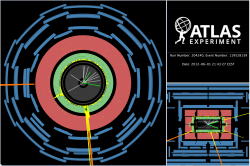MEPhI scientists observed Z-boson production with two associated photons in collaboration with their international colleagues from CERN

International group of physicists, which includes MEPhI scientists, for the first time managed to observe Z-boson production with two associated photons with later Z decay to electrons, muons or neutrino at ATLAS experiment at Large Hadron Collider (LHC) in CERN.
Observation of this extremely rare physics process, predicted by theory in 1960-s, has become another proof of the Standard Model (SM), said one of ATLAS experiment members and engineer of Department of Elementary Particles Physics (MEPhI) Dimitrii Krasnopevtsev.
Such rare process as Z-boson production with two associated photons is an important test of electro-weak sector of SM theory with the highest precision. At the moment our group has not found any deviations from theoretical predictions; in other words, we have once again confirmed Standard Model”, - he explained.
Scientists studied Z-boson production with one or two associated photons. It required precise measurements of the process possibility along with kinematic parameters of registered particles.
“Precision improvements are important to test Standard Model predictions. In our study we put limits on “exotic” theories, which can contribute to the final state of Z production with photons.
So-called intermediate bosons W± and Z were discovered in CERN in 1983. W- and Z-bosons were produced in proton-antiproton collisions with energies of 540 GeV. All three of these particles are very short-lived, with a half-life of about 3×10−25 s and can be detected only by their decay products.
Standard Model is a general theory describing interactions and particles, at the best level known by physicists at the moment. One of the most important tasks in modern high energy physics is the experimental test of its predictions. Nowadays scientists have not found any deviations from this theory, but there are large uncertainties in some measurements and some processes are so rare, that there are still possibilities to observe new phenomena.
Scientists from MEPhI added that such triboson production studies (Z-boson with two photons) show that energy and integrated luminosity at Large Hadron Collider allow us to start the most precision measurements of SM with very rare processes.
Scientists from MEPhI, Argonne National Laboratory of the US Department of Energy, Duke University of the US and South methodical University took part in the work.
Based on RIA Novosti material
27.06.2016

